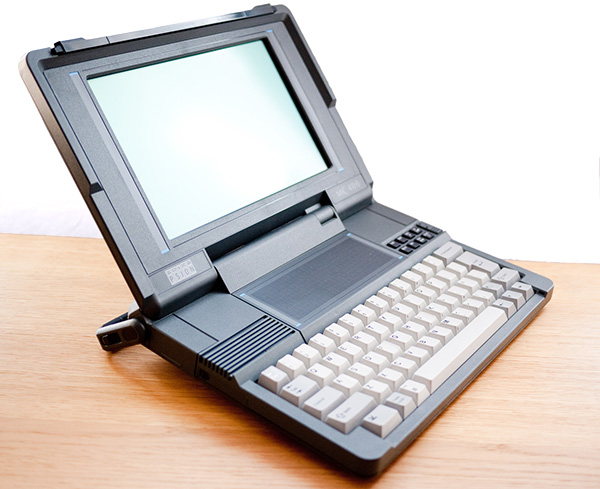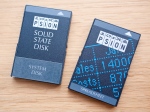Probably in my top five of most wanted retro machines I’ve finally acquired a Psion MC 400 mobile computer. Originally released back in 1989 this ill-fated machine, described by Time Magazine in their All Time 100 Gadgets as one of five gadgets ahead of their time, was initially priced in the UK at £845.00 and according to some sources sold less than a thousand units.
It is therefore unsurprisingly quite rare. Way ahead of its time it featured the first touchpad, removable storage in the form of sold state disks (SSDs) and a claimed battery life from 8 AA alkaline batteries of 60 hours.
Lack of compatibility, proprietory interfaces and a high price no doubt all contributed to its lack of success but you have to admire the manner in which its designers and engineers pushed the boundaries to create a gorgeous product that is reminiscent of what Apple do so well.
The Psion is powered by an Intel 80C86 processor and has 256 Kb of memory. For external connectivity there’s a standard parallel port, a 9 pin mini DIN RS232 port and Psion’s fast serial link, a precursor if you like to USB. The parallel and RS232 ports are contained within a removable module that slides into one of the two identical sockets found on the rear of the machine. Other modules including a modem were available, my MC 400 has a dummy module in the second socket.
There are four sockets for SSDs, two on either side of the machine and these are compatible with the SSDs used in the Series 3. The touchpad mimics the screen, so the position of your finger on the pad will correspond with the cursor position on the screen and the whole pad is clickable. In practise it doesn’t work particularly well, needing a lot more pressure to move the cursor than we’ve grown accustomed to with modern machines and accuracy is poor. Fortunately, navigating the GUI with the keyboard is pretty efficient once you’ve learnt the required key combinations.
The screen is a non-backlit retardation film LCD with a 640 x 400 resolution. It’s crisp but needs careful positioning of lighting for optimal viewing. The contrast can be adjusted by way of a dedicated function key found to the right side of the touchpad.
The MC400 runs the Psion developed EPOC graphical operating system, a preemptive multitasking OS which would in later years evolve into the Symbian OS adopted by Nokia for its early smartphones.
A suite of software applications are supplied on SSD, a text editor, diary, personal database, calculator, file manager, terminal emulator and word processor. Not a great deal of other software was available as far as I can tell although my MC 400 did come with an additional spreadsheet on SSD.
There were two NiCad battery packs available or you can use 8 standard AA type alkaline batteries which reportedly give an extraordinary 60 hours plus of usage. I’m currently using rechargeable Duracell AA’s and will be interested to see how long they last.
The included Link software can be used in conjunction with Psion’s PsiWin software (available here) and a suitable cable to transfer data backwards and forwards between the Psion and a PC via the RS232 interface. I was concerned it would be difficult to locate or build a suitable cable for the non-standard 9 pin mini DIN but discovered here that you can use a Series S3/S3A’s lead.
I plan therefore to acquire one of these cables and see if I can get PsiWin working and also if I can hook up a modem. I’m also going to look at doing some programming with OPL, Psion’s structured programming language.
Some useful resources:-







